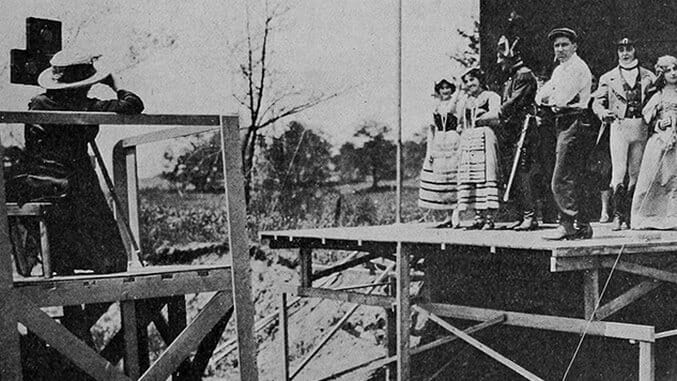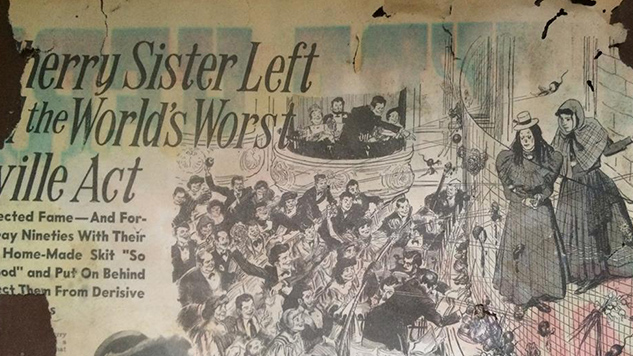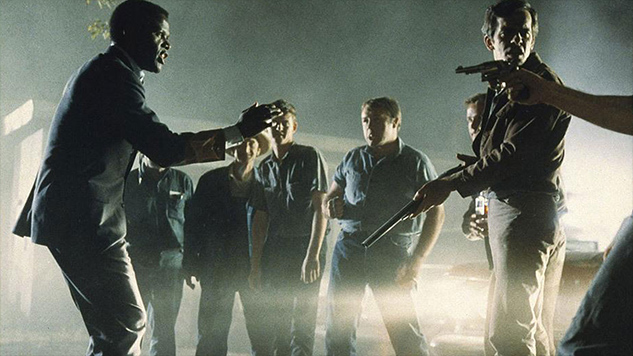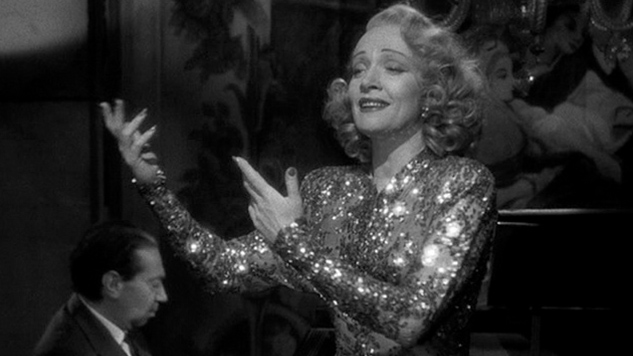Remember This? 5 Hidden Hollywood Histories that Deserve the Big-Screen Treatment
Enough with the reboots and sequels: Hollywood has plenty of stories available right in its own back yard.
Movies Lists Hollywood
Hollywood is a curious place. Full to the brim with all manner of oddball personalities, the daily lives of those in showbiz are anything but ordinary. Or, at least, that’s what we’re supposed to think: Hollywood, and by extension the entertainment industry, has a fascination with watching itself. There’s an entire canon of films devoted to this in one way or another, from Sunset Boulevard to Hail, Caesar!, from The Player to Birdman. And if there’s one bankable way to spin a yarn about Hollywood, it’s best to go with the “based on a true story” format. The appetite for films of this nature is evident enough in the amount of films still being produced, amongst reboots and sequels and franchises, attached to those five words.
Look only to acclaimed podcast You Must Remember This, which shines a light on the hidden histories of Hollywood. What becomes evident very quickly is that countless juicy stories are going untold: True tales of sex, murder, politics and even farce have kept the gears of Hollywood greased, so why not pull from those stories happening right in its own back yard? Ranging from timely to wild to downright weird, the following true Hollywood stories could easily (and lucratively) find a home couched comfortably within the blockbuster tent-poles we’re so used to seeing lately—and the industry is so used to depending upon.
1. The Cherry Sisters

What’s the story?
Simply put, the Cherry Sisters were a disaster —and yet somehow their act made it to one of the biggest theaters in New York City. These five women, orphaned at a young age, made a name for themselves originally on the Cedar Rapids circuit with their cringe-worthy vaudeville act, which featured such onstage antics as bass-drum playing, poetry recitals, essay reading and fake hypnosis. The small crowds they played to were bewildered by their confidently talentless exploits, yet nobody had the heart to tell them they were awful, so they soldiered on, replacing a lack of actual ability with sheer confidence. Eventually, in spite of the jeers, their act caught the eye of theater producer Oscar Hammerstein, who ultimately got them onto the stage at the Olympia Music Hall in New York City.
Why a movie?
With Hollywood more open to pushing female comedy teams, this is a story begging to be brought to life by some of our best comedic women. With Stephen Frears and Meryl Streep at the helm of Florence Foster Jenkins (a dramatization of the life of the eponymous opera singer, famously shrill yet beloved) there could be room to replicate. Like Jenkins, the Cherry Sisters were a mess, but they were an endearing one. Imagine the possibilities of Ilana Glazer, Abbi Jacobsen and Jillian Bell becoming sisters, delightfully slapdash in their take on these forgotten women of the vaudeville stage.
2. The Assassination of Dorothy Kilgallen

What’s the story?
It’s November 8, 1965, nearly two years after the assassination of John F. Kennedy. Journalist turned What’s My Line? panelist Dorothy Kilgallen is discovered in bed, fully clothed and stone-cold dead. Kilgallen built her journalistic career first as a Hedda Hopper-esque Hollywood gossip columnist and then as a radio show host with husband Richard Kollmar. She finally achieved notoriety on What’s My Line?, where co-panelist Bennett Cerf would remember Kilgallen as politically conservative, upholding the McCarthy-era positions against Hollywood liberalism.
While ostensibly a tabloid journalist, Kilgallen dedicated the last years of her life and writing career to investigating the true nature of the Kennedy assassination—an investigation which, it’s widely speculated today, led to her murder. One red flag: her autopsy showed the presence of barbiturates in her system, something Kilgallen was not regularly taking. Reports also indicate she met with a mysterious figure in a hotel restaurant the night before her death.
Why a movie?
Hollywood’s fascination with crime is long-standing—whether it’s fictional film noir or true crime dramas, murder means money. Kilgallen’s body of work—shaped by television, gender and society—echoes that of Christine Chubbuck’s, whose own life has been adapted into a meta-documentary (Kate Plays Christine) and a drama (Christine), both due out this year. Like Chubbuck, Kilgallen was a strong personality, representative of social set of values that was quickly becoming outmoded—and yet, she fought to keep her credibility until the very end, challenging and skewing ideas about power and gender to the point of her own demise.
3. The Affair of Marlene Dietrich and Joe Kennedy, Sr.
What’s the story?
While the Hôtel du Cap is home to many a Hollywood-expat-in-France tale, the one you may be surprised to hear about is the brief affair between Marlene Dietrich and Joseph Kennedy, Sr. Both summered at the hotel in 1938, escaping the limelight of Hollywood and ambassadorial duties, respectively, with their children in tow. Dietrich had recently fallen victim to being branded “box office poison,” experiencing a dip in her work. Kennedy had gathered his brood to take a European vacation while the kids were on a school break.
The lovers met through their children: Dietrich’s sheltered daughter, Maria, became friends with shy Rosemary Kennedy, inviting her one Kennedy family gathering after another. It was only a matter of time before Dietrich herself swanned in and caught the eye of Kennedy himself. Theirs was a fiery and brief affair, a dalliance repeated in the summer of 1939, when Kennedy’s political duties took him all over Europe before returning him to du Cap, where Dietrich, though she was summering with another lover, still found time time for Kennedy in the afternoons. They were not each other’s first or last extramarital lover, but there was little question they struck up an intense match.
Why a movie?
It’s a story Woody Allen or Whit Stillman could tell best: an arthouse rendering of two of Hollywood’s Golden Age elite crossing paths and falling into bed together. Both Dietrich and Kennedy were known for their public affairs, their sexual appetites almost as notable a quality as their high-ranking social status in Hollywood. Both had strong personalities that were, in 1938, as political as they were glamorous. It’s not only their unexposed lives that could make for a deliciously sordid story, it’s the clash between their public and private personas that could yield timeless results on camera.
4. Alice Guy-Blaché and Her Gender-Bending Films

What’s the story?
Racking up over 400 directing credits between 1896 and 1920, Alice Guy-Blaché often used her short films to challenge both narrative forms and the roles male and female performers should embody. Just as the first wave of feminism was breaking through to the mainstream, Guy-Blaché was using film as a platform to discuss the topic (as in her short film The Consequences of Feminism) openly. Other films saw men dressing as women or women dressing as men, trading expectation for reinvention—in Pierette’s Escapades, Guy-Blaché casts two women into that of a heterosexual pairing, the two flirting and swirling around each other and casting a new light on traditional romantic narratives with an all-female cast. Guy-Blaché’s output was prolific, her subject matter indicative of shifting attitudes towards the status of women at the beginning of the 20th century.
Why a movie?
Guy-Blaché is the definition of an industry pioneer, rising first through Gaumont Studios, then by becoming the founder and head of Solax Studios. By all accounts a cisgender woman, she nonetheless challenged masculine stereotypes, making big meaningful moves like casting women into then-typically male professions, like magicians or dog-trainers, and taking on the masculine roles herself, dressing as a man and stepping in front of the camera. Today, as we continue to mold our perspectives on how we conceptualize gender and sexuality in mainstream artr, Guy-Blaché’s story is both a feminist rendering of an inherently masculine system, and a subversion of how women were expected to perform both on- and off-screen.
5. The 1968 Oscars

What’s the story?
Less than a week after the assassination of Martin Luther King, Jr., the 40th Academy Awards went on as scheduled despite protests from celebrities that the timing was less than ideal. The studio system of Golden Age Hollywood was already past its sell-by date and the turmoil stemming from the assassination did nothing to assuage fears that the status quo would remain intact. As the nation came to a boiling point over mounting racial tensions, threats of empty seats at the awards ceremonies loomed. Many nominees felt it would be inappropriate to attend when the nation was ostensibly coming apart at the seams.
Cinema’s shifting tastes meant that many of the films nominated that year, including Guess Who’s Coming To Dinner and In The Heat of The Night, were tackling issues of race in America, adding an overt sobriety to the affair. To many members of the Academy, it felt morally incongruous to have such an ostentatious celebration in the wake of such a civil grievance. To assure attendees like Diahann Carroll, Sammy Davis Jr., Louis Armstrong and Sidney Poitier, Academy President Gregory Peck assembled a last-minute meeting to agree on pushing back the date of the ceremony.
Why a movie?
Ensemble films offer the opportunity to showcase the chops of a multitude of actors; add that to a politically or racially-charged ensemble pic (think Bobby or The Butler) and the buzz will be big. On the heels of the fraught diversity conversation that was #OscarsSoWhite, adapting this story could serve as a continued reminder that the industry is still long over-due for another shift in its practices. Adding another element of timeliness are the circumstances surrounding Poitier’s involvement in the ceremony. While he was a lead in both Guess Who’s Coming To Dinner and In The Heat of The Night, he failed to garner any nominations himself. In fact, in a year when there were multiple opportunities to reward black performers, only one was recognized: Beah Richards for Guess Who’s Coming To Dinner. Echoes of systemic racial injustice were heard at this year’s Oscar ceremonies; an adaptation of this snapshot in time could serve as a sobering reminder that history tends to repeat itself.
